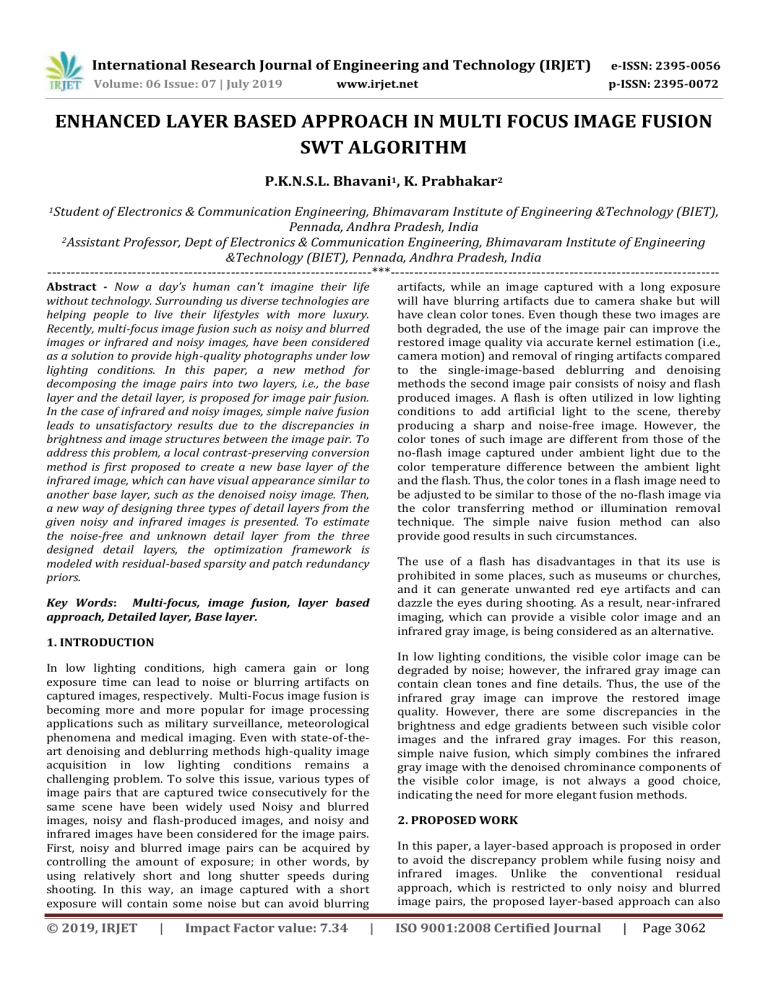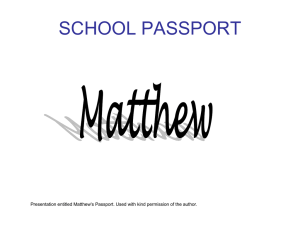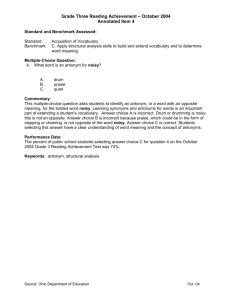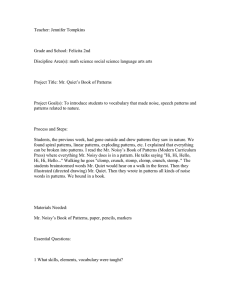IRJET- Enhanced Layer based Approach in Multi Focus Image Fusion SWT Algorithm
advertisement

International Research Journal of Engineering and Technology (IRJET) e-ISSN: 2395-0056 Volume: 06 Issue: 07 | July 2019 p-ISSN: 2395-0072 www.irjet.net ENHANCED LAYER BASED APPROACH IN MULTI FOCUS IMAGE FUSION SWT ALGORITHM P.K.N.S.L. Bhavani1, K. Prabhakar2 1Student of Electronics & Communication Engineering, Bhimavaram Institute of Engineering &Technology (BIET), Pennada, Andhra Pradesh, India 2Assistant Professor, Dept of Electronics & Communication Engineering, Bhimavaram Institute of Engineering &Technology (BIET), Pennada, Andhra Pradesh, India ---------------------------------------------------------------------***---------------------------------------------------------------------Abstract - Now a day’s human can't imagine their life without technology. Surrounding us diverse technologies are helping people to live their lifestyles with more luxury. Recently, multi-focus image fusion such as noisy and blurred images or infrared and noisy images, have been considered as a solution to provide high-quality photographs under low lighting conditions. In this paper, a new method for decomposing the image pairs into two layers, i.e., the base layer and the detail layer, is proposed for image pair fusion. In the case of infrared and noisy images, simple naive fusion leads to unsatisfactory results due to the discrepancies in brightness and image structures between the image pair. To address this problem, a local contrast-preserving conversion method is first proposed to create a new base layer of the infrared image, which can have visual appearance similar to another base layer, such as the denoised noisy image. Then, a new way of designing three types of detail layers from the given noisy and infrared images is presented. To estimate the noise-free and unknown detail layer from the three designed detail layers, the optimization framework is modeled with residual-based sparsity and patch redundancy priors. Key Words: Multi-focus, image fusion, layer based approach, Detailed layer, Base layer. 1. INTRODUCTION In low lighting conditions, high camera gain or long exposure time can lead to noise or blurring artifacts on captured images, respectively. Multi-Focus image fusion is becoming more and more popular for image processing applications such as military surveillance, meteorological phenomena and medical imaging. Even with state-of-theart denoising and deblurring methods high-quality image acquisition in low lighting conditions remains a challenging problem. To solve this issue, various types of image pairs that are captured twice consecutively for the same scene have been widely used Noisy and blurred images, noisy and flash-produced images, and noisy and infrared images have been considered for the image pairs. First, noisy and blurred image pairs can be acquired by controlling the amount of exposure; in other words, by using relatively short and long shutter speeds during shooting. In this way, an image captured with a short exposure will contain some noise but can avoid blurring © 2019, IRJET | Impact Factor value: 7.34 | artifacts, while an image captured with a long exposure will have blurring artifacts due to camera shake but will have clean color tones. Even though these two images are both degraded, the use of the image pair can improve the restored image quality via accurate kernel estimation (i.e., camera motion) and removal of ringing artifacts compared to the single-image-based deblurring and denoising methods the second image pair consists of noisy and flash produced images. A flash is often utilized in low lighting conditions to add artificial light to the scene, thereby producing a sharp and noise-free image. However, the color tones of such image are different from those of the no-flash image captured under ambient light due to the color temperature difference between the ambient light and the flash. Thus, the color tones in a flash image need to be adjusted to be similar to those of the no-flash image via the color transferring method or illumination removal technique. The simple naive fusion method can also provide good results in such circumstances. The use of a flash has disadvantages in that its use is prohibited in some places, such as museums or churches, and it can generate unwanted red eye artifacts and can dazzle the eyes during shooting. As a result, near-infrared imaging, which can provide a visible color image and an infrared gray image, is being considered as an alternative. In low lighting conditions, the visible color image can be degraded by noise; however, the infrared gray image can contain clean tones and fine details. Thus, the use of the infrared gray image can improve the restored image quality. However, there are some discrepancies in the brightness and edge gradients between such visible color images and the infrared gray images. For this reason, simple naive fusion, which simply combines the infrared gray image with the denoised chrominance components of the visible color image, is not always a good choice, indicating the need for more elegant fusion methods. 2. PROPOSED WORK In this paper, a layer-based approach is proposed in order to avoid the discrepancy problem while fusing noisy and infrared images. Unlike the conventional residual approach, which is restricted to only noisy and blurred image pairs, the proposed layer-based approach can also ISO 9001:2008 Certified Journal | Page 3062 International Research Journal of Engineering and Technology (IRJET) e-ISSN: 2395-0056 Volume: 06 Issue: 07 | July 2019 p-ISSN: 2395-0072 www.irjet.net be applied to noisy and infrared image pairs. Moreover, the proposed approach can remove ringing artifacts. In this paper, a local contrast-preserving image conversion method is introduced in order to create a new base layer of the infrared image. This conversion method enables the appearance of the new base layer of the infrared image to be similar to that of another base layer, i.e., the denoised noisy image, so the discrepancy problem can be avoided during base layer fusion. A method for designing the detail layers of noisy and infrared images is provided in this paper. The detail layer of the noisy image is generated based on the difference between the noisy image and its denoised version. In contrast, the infrared image has two types of detail layers due to the newly created base layer. One is created using the difference between the infrared image and its denoised version, and the other is based on the difference between the new base layer and its sharpened version. This detail layer design method can not only effectively reduce the noise in the detail layer of the noisy image, but also amplifies the fine details in the detail layer of infrared images. The proposed system works as follows: In the proposed system suggest that the image pair fusion method is to solve the discrepancy problem between noisy and infrared images, a local contrast-preserving conversion method was developed, thereby enabling the appearance of the base layer of the infrared image to be close to that of the noisy image. In addition, a new way of designing three types of detail layers that contain different information, e.g., highlights, edges, or textures, was introduced. This detail layer design leads to improvement in the edge and texture representations. Also, the proposed residual-based sparse coding effectively suppresses the noise in the detail layer of the noisy image through a feedback loop. In detail the proposed layer-based approach is applied for both noisy and blurred image pair. Unlike the noisy and infrared image pair, the noisy and blurred image pair has one base layer and two detail layers indicates that the base layer is the same as the denoised noisy image with the nonlocal means denoising method. The detail layer of the noisy image is the difference between the noisy image and the base layer. On the other hand, the detail layer of the blurred image is the difference between the blurred image and the convolved base layer. The noisy and infrared image pair, the noisy and blurred images are both degraded, and thus nonlocal redundancy regularization is helpful to suppress noise and ringing artifacts. The primary goal of this paper is to develop a new method for fusing the noisy and infrared images. More details will be provided to show how well the proposed layer-based approach overcomes the discrepancy problem and provides high-quality images with low noise and sharp edges. The secondary goal is to show that the proposed layer-based approach can also be applied to another type of image pair, i.e., noisy and blurred images. It is particularly noteworthy that the ringing artifacts are better mitigated by the proposed model than by the conventional residual model. However, the fusion of a noisy and flash-produced image pair was not tested in this paper because the naive method and color transferring method produce satisfactory results for such image pairs. 3. EXPERIMENTAL RESULTS The performance metrics such as accuracy and time efficiency were calculated. Fig: Noisy blurred Image and Infrared Image © 2019, IRJET | Impact Factor value: 7.34 | ISO 9001:2008 Certified Journal | Page 3063 International Research Journal of Engineering and Technology (IRJET) e-ISSN: 2395-0056 Volume: 06 Issue: 07 | July 2019 p-ISSN: 2395-0072 www.irjet.net Fig: Fusion Image Fig: Noisy blurred Image and Deblurred Image Fig: Output of Deblurred Fusion Image Fig: Noisy and Denoised infrared Image Fig: Output of denoised Fusion image © 2019, IRJET | Impact Factor value: 7.34 | ISO 9001:2008 Certified Journal | Page 3064 International Research Journal of Engineering and Technology (IRJET) e-ISSN: 2395-0056 Volume: 06 Issue: 07 | July 2019 p-ISSN: 2395-0072 www.irjet.net Fig: Comparison PSNR for all image fusion Fig: PSNR for Blurred and Deblurred image Fig: PSNR for Noisy and Denoised infrared image Fig: PSNR for Fusion image 4. CONCLUSION AND FUTURE WORK A new layer-based image pair fusion method was proposed. To solve the discrepancy problem between noisy and infrared images, a local contrast-preserving conversion method was developed, thereby enabling the Fig: Comparison of PSNR input and output image © 2019, IRJET | Impact Factor value: 7.34 | ISO 9001:2008 Certified Journal | Page 3065 International Research Journal of Engineering and Technology (IRJET) e-ISSN: 2395-0056 Volume: 06 Issue: 07 | July 2019 p-ISSN: 2395-0072 www.irjet.net appearance of the base layer of the infrared image to be close to that of the noisy image. In addition, a new way of designing three types of detail layers that contain different information, e.g., highlights, edges, or textures, was introduced. This detail layer design leads to improvement in the edge and texture representations. Also, the proposed residual-based sparse coding effectively suppresses the noise in the detail layer of the noisy image through a feedback loop. Furthermore, the experimental results showed that the proposed layerbased method can also be applied to noisy and blurred image pairs. Future work shall include evaluating the platform behavior in terms of scalability and performance with larger amounts of data as well as evaluating other ML cases, while possesses similar or even better fusion quality using both visual inspection and quantitative metrics. [7] J. van de Weijer, T. Gevers, and A. Gijsenij, “Edge-based color constancy,” IEEE Trans. Image Process., vol. 16, no. 9, pp. 2207–2214,Sep. 2007. [8] C. Fredembach and S. Süsstrunk, “Colouring the near infrared,” in Proc.16th Color Imag. Conf., 2008, pp. 176– 182. [9] Q. Yan et al., “Cross-field joint image restoration via scale map,” in Proc. IEEE Int. Conf. Comput. Vis., Oct. 2013, pp. 1537–1544. [10] R. Kakarala and R. Hebbalaguppe, “A method for fusing a pair of images in the JPEG domain,” J. Real-Time Image Process., vol. 9, no. 2,pp. 347–357, Jun. 2014. ACKNOWLEDGEMENT The success of this review paper requires more guidance from lot of peoples and we got more support to collect this valuable information to complete this work. We are able to complete this only due to proper supervision and observation and so would not forget to thank them. Also, we are thankful to our college for providing all the facilities for such a great opportunity. REFERENCES [1] M. Elad and M. Aharon, “Image denoising via sparse and redundant representations over learned dictionaries,” IEEE Trans. Image Process., vol. 15, no. 12, pp. 3736–3745, Dec. 2006. [2] S. Cho and S. Lee, “Fast motion deblurring,” ACM Trans. Graph., vol. 28, no. 5, Dec. 2009, Art. no. 145. [3] L. Yuan, J. Sun, L. Quan, and H.-Y. Shum, “Image deblurring with blurred/noisy image pairs,” ACM Trans. Graph., vol. 26, no. 3, Jul. 2007,Art. no. 1. [4] S. Zhuo, D. Guo, and T. Sim, “Robust flash deblurring,” in Proc. IEEE Comput. Vis. Pattern Recognit., Jun. 2010, pp. 2440–2447. [5] S. Zhuo, X. Zhang, X. Miao, and T. Sim, “Enhancing low light images using near infrared flash images,” in Proc. Int. Conf. Image Process., Sep. 2010, pp. 2537–2540. [6] Y.-W. Tai, J. Jia, and C.-K. Tang, “Local color transfer via probabilistic segmentation by expectation-maximization,” in Proc. IEEE Comput. Vis. Pattern Recognit., Jun. 2005, pp. 747–754. © 2019, IRJET | Impact Factor value: 7.34 | ISO 9001:2008 Certified Journal | Page 3066



